Category Archive for Art + Design
A guide to Yangon’s modern art galleries! Burma Pansodan & River gallery.
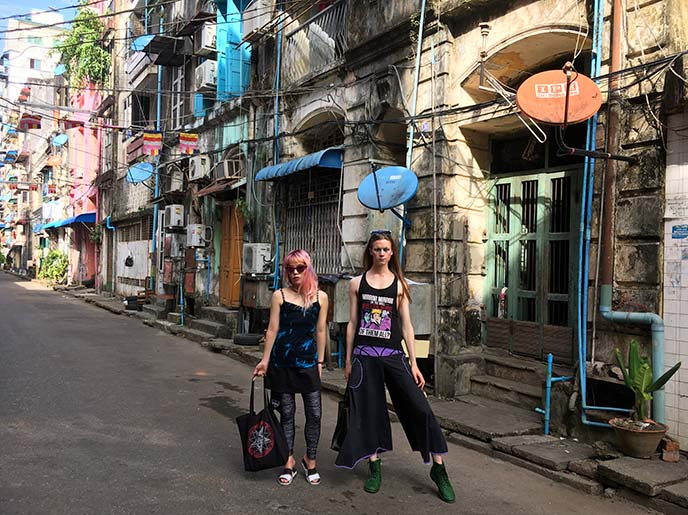
Let’s continue our Myanmar escapades… with a tour of the progressive art and photography galleries of Yangon!
Burmese artists are spreading their wings, now that they are free from military rule and censorship. With the support of these independent galleries, local creators are able to express themselves in ways that were previously forbidden (such as by painting nudes and political topics).
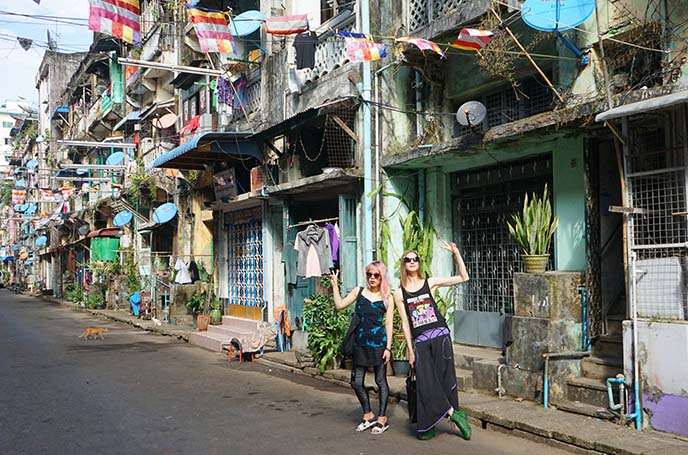
Yukiro and I are certainly “women who explore” — so let’s give you a tour of Yangon’s top galleries.
We stayed at ParkRoyal hotel, and they bestowed us with a car and driver that made getting from place to place much easier. I looked up a few Burmese art exhibits, and gave our driver the list. He figured out the most efficient route, which made it possible for us to see five venues that day: Pansodan, River, Nawaday Tharlar, New Zero, and Deitta.
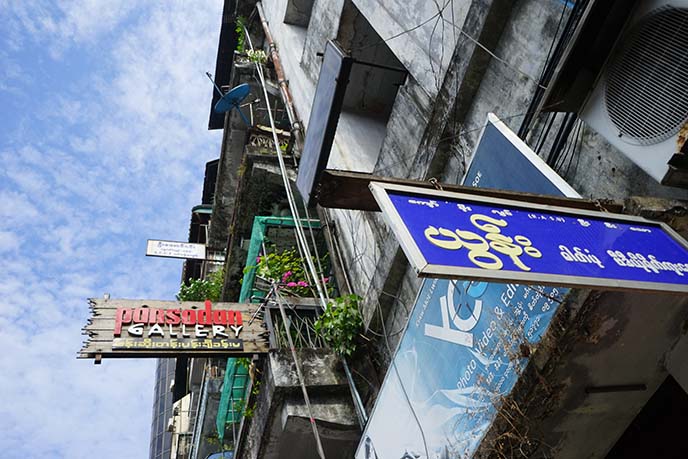
We started our art tour at Pansodan Gallery, which we heard was one of the best in the city.
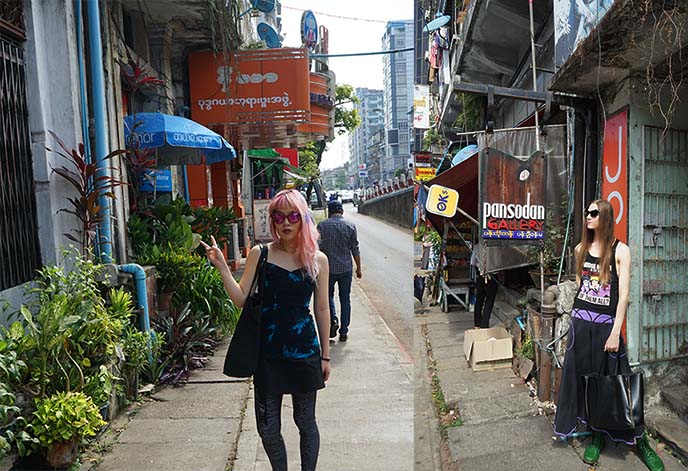
Love the greenery and vivid street signs near the entrance of Pansodan Gallery. Walk up the stairs, and you’re there.
Address: 1st Floor, 286, Pansodan Street, (Upper Block), Kyauktada Township, Yangon, Myanmar.
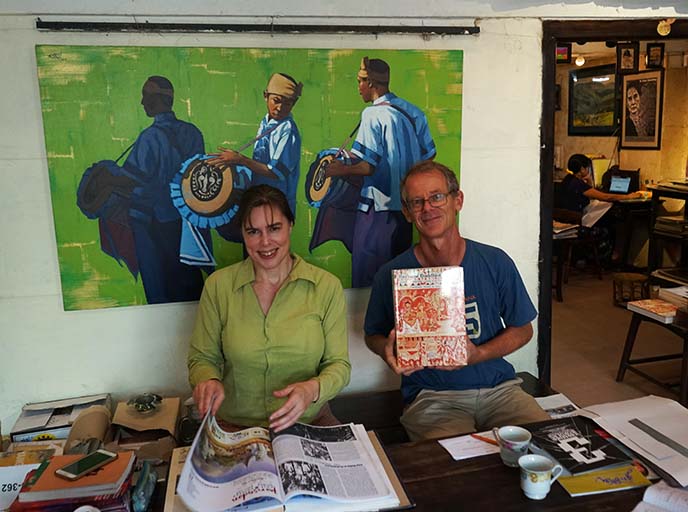
Pansodan Gallery was established in August 2008 by Aung Soe Min and Nance Cunningham, a Canadian who has lived in Burma since the 1990s.
We chatted with Nance and her French friend Christophe Munier, who recently published a book called Burmese Buddhist Murals. He told us that a lot of spiritual art from past centuries has been destroyed. His book attempts to document these works before they are gone, as preservation is unfortunately a challenge in a country with limited budget for the arts.
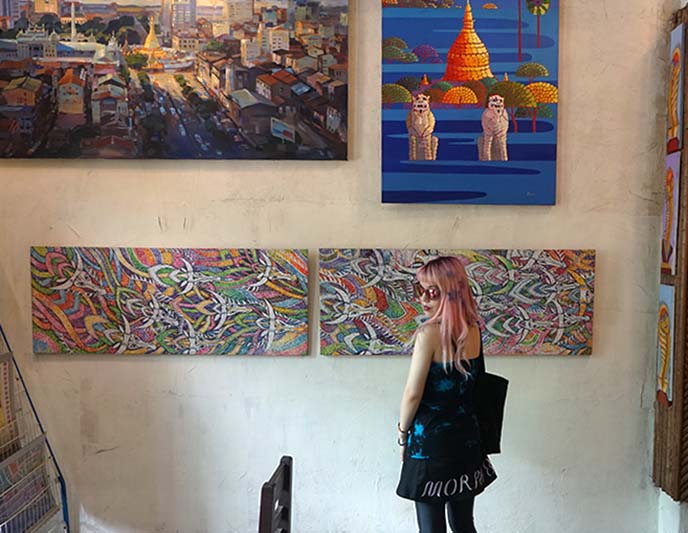
On the bright side, a gallery like Pansodan is a welcoming space, which gives Burmese artists a chance to present their works to worldwide audiences. The selection ranges from budding artists to older masters, working in a variety of mediums.
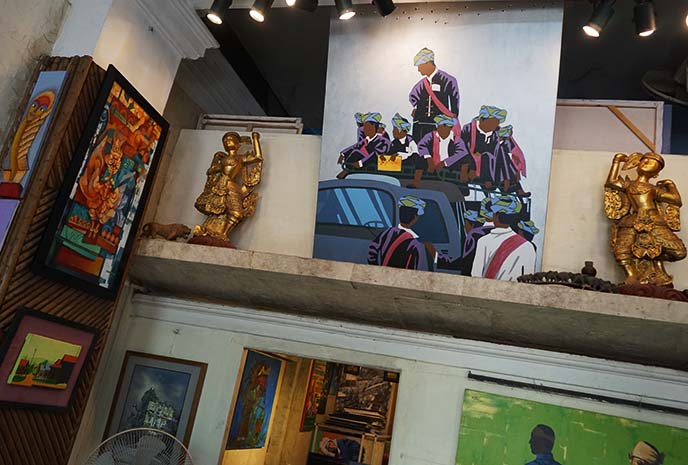
Pansodan Gallery also aims to make the local art accessible. Some of the paintings are in higher price ranges, but there’s a great selection of watercolors, cards, books and other small items for $10-30 US.
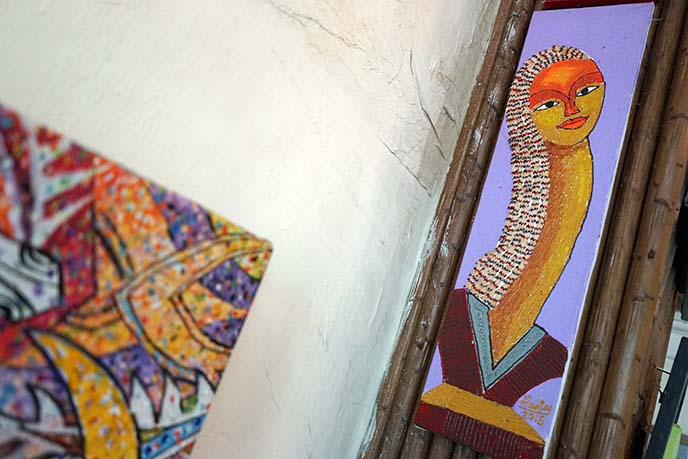
We loved seeing these fun, modern expressions of Burmese culture on the walls. Works like these were brimming with color and energy.
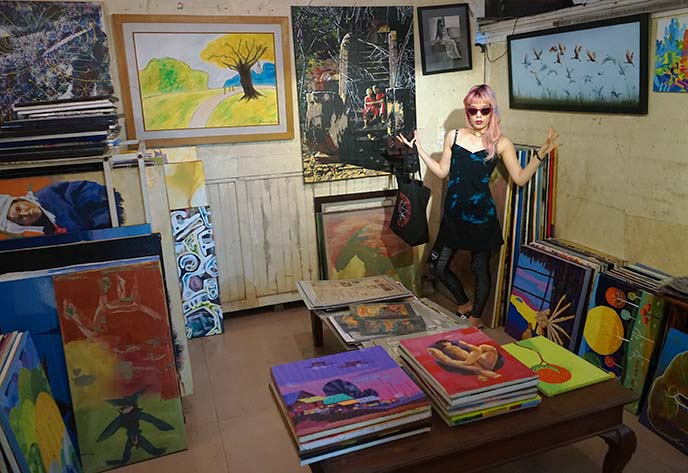
After years under the military government, Myanmar has opened up. In the past, only non-controversial, sanctioned subjects like landscapes were permitted. Now, artists are free to express any topics and themes without censure.
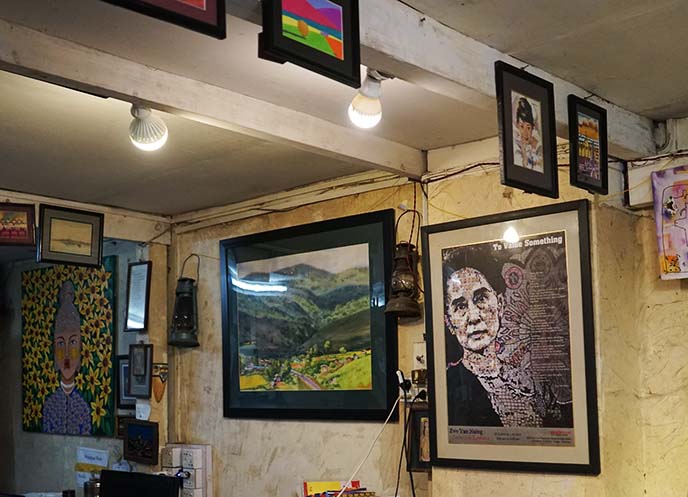
Before the current democratic government, it was difficult (to say the least!) to be an artist in Myanmar. Art supplies were often scarce, and if the military deemed your works to be offensive, they’d be confiscated. It was even forbidden to display photos and paintings of “The Lady,” Aung San Suu Kyi.
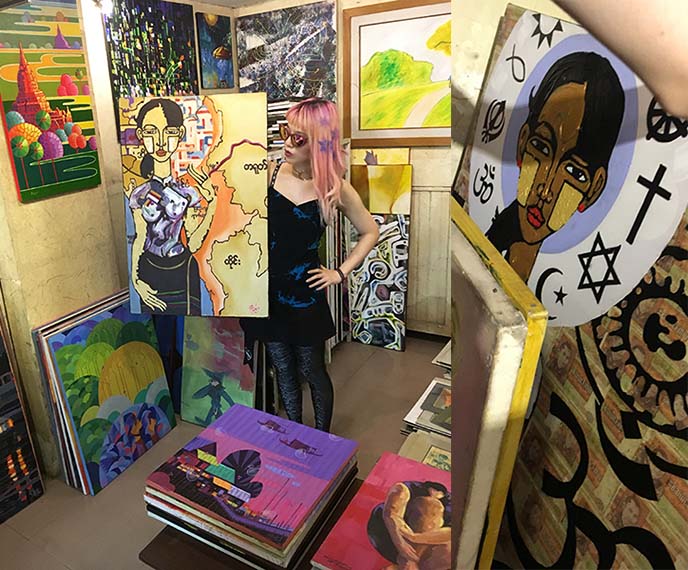
Now that she’s the leader of the democracy, the arts have flowered. This liberalisation has enabled artists to depict nudes, and political or edgy subjects for the first time. Many choose to paint Aung San Suu Kyi, as you can see in the examples above.
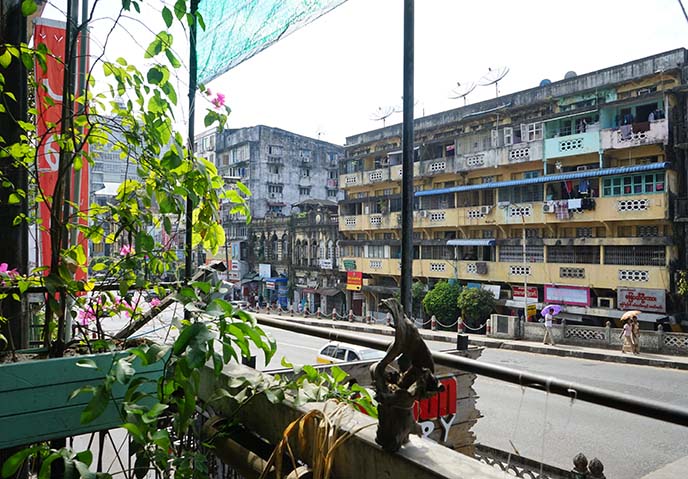
Pansodan Gallery encourages this creative renaissance in many ways, including running a laid-back social event every Tuesday night. Anyone can come to enjoy beer and snacks, talk art, and meet others.
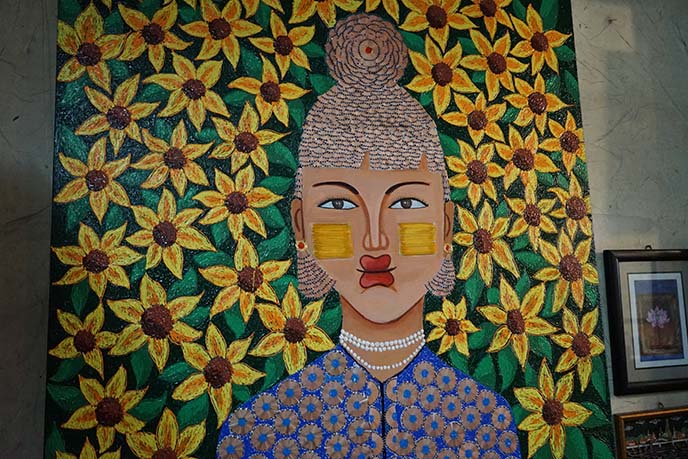
The owners have also opened up a new space called Pansodan Scene recently. In addition to displaying paintings, the Scene has poetry readings, talks, concerts, and a small cafe.
(Address: 144, 2nd Floor, Pansodan Street, Corner of Mahabandoola Street, Kyauktada Township, Yangon)
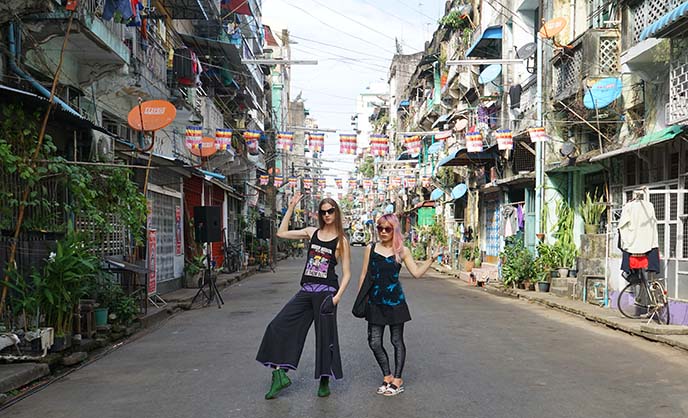
Yukiro and I consider the streets of Yangon to be works of art in themselves! So many colors and textures in a single block.
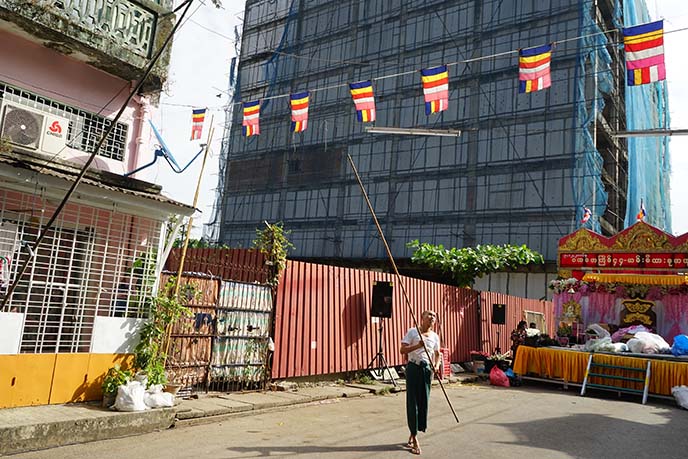
We watched this man hang up spiritual flags, as he prepared a stage for a Buddhist event.
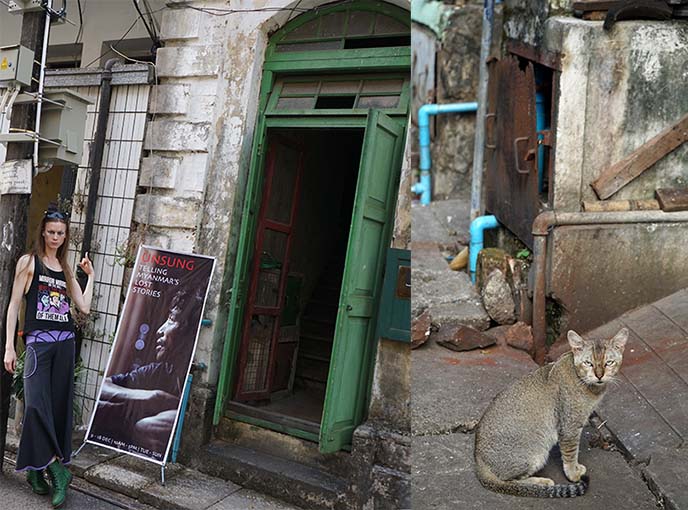
We said hello to a few cats, on the way to our next stop: Myanmar Deitta gallery. (Address: No.49, 44th St, Yangon, Burma).
This is a not-for-profit organisation that supports photographers, filmmakers and other multimedia producers in Myanmar. The upper level space hosts workshops and exhibitions, with the goal of presenting and discussing social issues that were formerly repressed by the military.

We caught the bilingual exhibit by The Kite Tales Project, titled “Unsung Heroes: Telling Myanmar’s Lost Stories.” Run by two journalists, Ma Thin Lei Win and Kelly Macnamara, this digital initiative captures the daily lives of people all throughout the country.
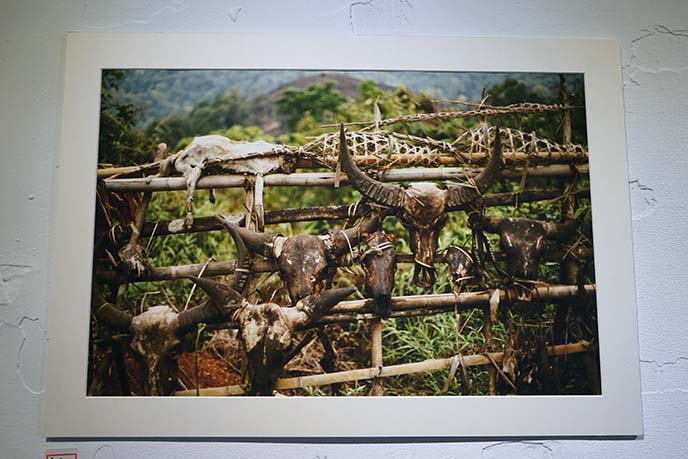
The journalists traveled all throughout Myanmar, including to remote and conflict regions. Through photo, video and audio, they recorded stories that had been silenced for decades, from a variety of perspectives.
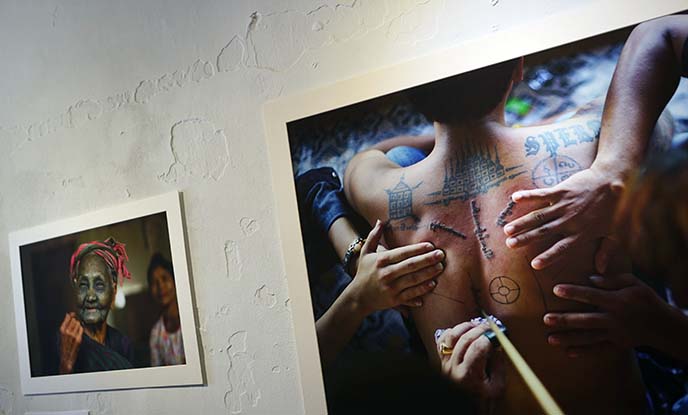
Naturally, I was drawn to these photographs of tribal tattoos and body modifications in Burma. On the left, a 90-year old woman from the ethnic Chin village sports a full-face blue tattoo. One of the reasons these women modify their appearance is to prevent other tribes from preying on them.
Another woman, a daughter of a Lahe chief, spoke about how her community once got tattoos to celebrate heroes and victories. She lamented that today the practice has become lost.
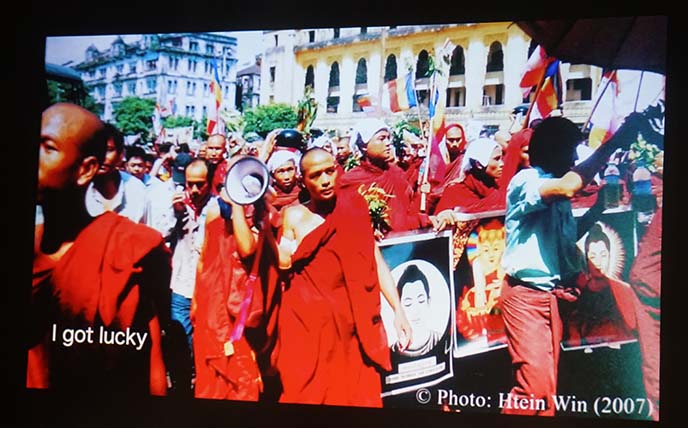
In the attic, we watched documentary footage from throughout the country. I was intrigued by these videos from the Saffron Revolution, a series of peaceful political demonstrations in 2007. Many Buddhist monks took part in this nonviolent resistance, wearing saffron-colored robes.
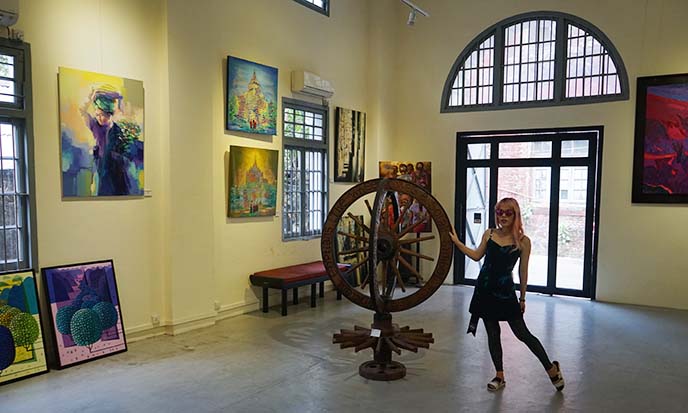
Onward to River Gallery, which was once housed in The Strand hotel. (Address: Chindwin Chambers 33/35, 37th and 38th Street, Yangon)
Yukiro opened his Pokemon Go app, and realized there were almost no Pokemon to catch in Myanmar. Nonetheless, this gallery had what looked like a wooden Poke-Stop sculpture, which you could even spin!

River Gallery is a high-ceilinged space that beautifully showcases the works of Myanmar’s leading contemporary artists. It’s a great place to pick up artistic souvenirs, as there are cups, jewelry and other fine items for sale.

Before the democratic leadership, Myanmar was isolated from the global art scene, and struggled under the draconian censorship. River Gallery was keen to create a space for local artists to get better representation and exposure.
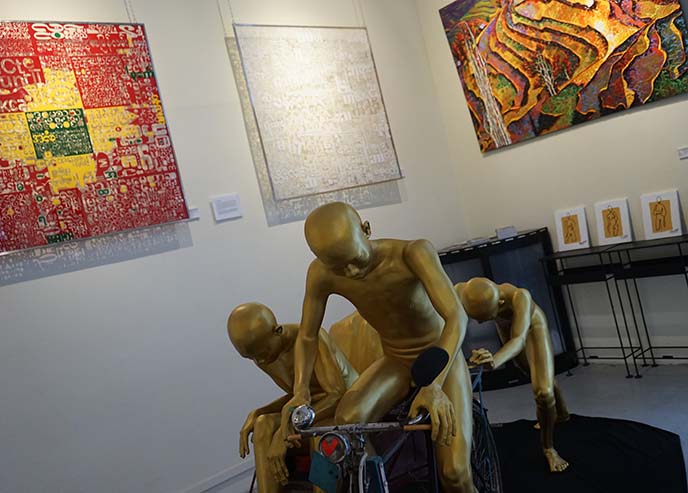
Here, you can see playful and abstract works by over 40 contemporary artists, who are now free from these restraints. River Gallery organises an annual show abroad for its talents as well.

In contrast, New Zero Art Space is a more obscure and underground gallery. We went into an apartment building, and searched for the door to this non-profit. (Address: No,202, 2nd Floor, United Condo, Ah Lan Pya Pagoda Road, Dagon Township Yangon 1181)

We stepped into “Identity of Fear: A Solo Exhibition by Mayco Naing.” The stark, white tiles of the space were the perfect backdrop to her black and white photographs.

The concept: young Burmese, immersed in baths, with their hands clasped over their faces. Naing’s photographs reflect the generation born around the 1988 Revolution. She and her fellow 20-30 year olds faced a volatile dictatorship, low educational standards and conservative values while growing up.

The underwater bathtub images represent the stifling educational opportunities she feels her peers have suffered. The nudity also confronts feelings of shame about the human body.
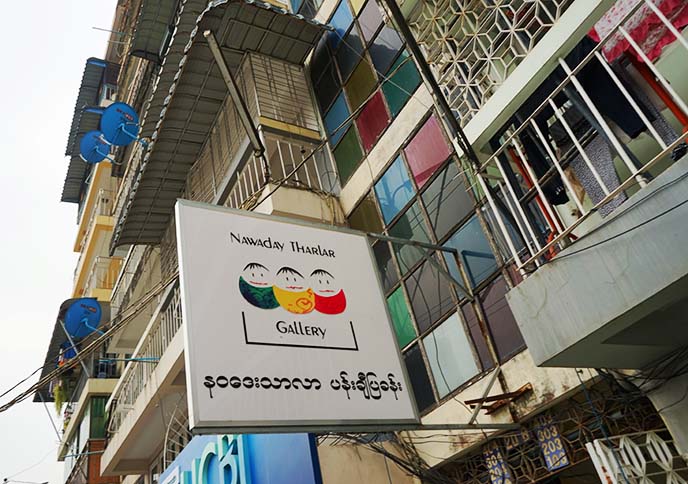
Before heading back to our ParkHotel, we stopped by the nearby Nawaday Tharlar gallery. The smiling kawaii logo is impossible to resist!
Address: Yaw Min Gyi road Building No. 20B Room No. 304, Yangon, Myanmar (Burma)
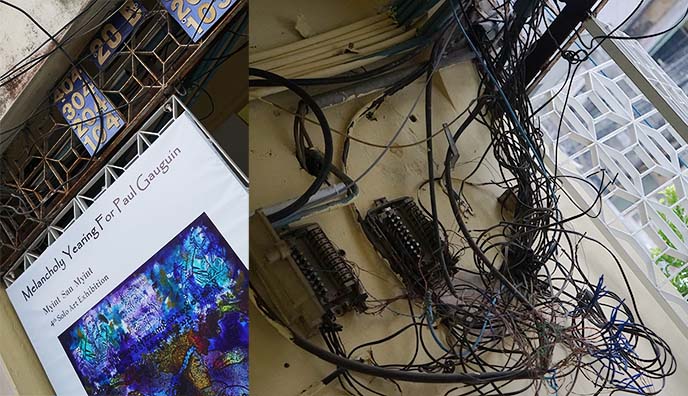
When we stepped into the entrance, we were mesmerised by the tangle of electrical wiring — that’s an art piece on its own!
Nawaday Tharlar opened in 2012, and is dedicated to creating a place for people to come together and share art, music, poetry and stories.

The gallery holds a bi-monthly open mic, where anyone can come to perform. It also hosts different creative activities, such as a tea and drawing workshop.

In the main room, we enjoyed the “Yangonoftheday One Year Exhibition.” This photography project posts images once a day, depicting some aspect of Yangon city life.

The concept shows all the facets of Yangon (Rangoon) and its people, and lets residents share their stories through Instagram-like square photos.

I spotted monks and punks. Birds and buildings.

In the back rooms, there are stacks upon stacks of canvases, from dozens of Burmese artists. Anyone can come to flip through them.

Buddhist themes abound, in this spiritual country. Isn’t the Burmese writing lovely?
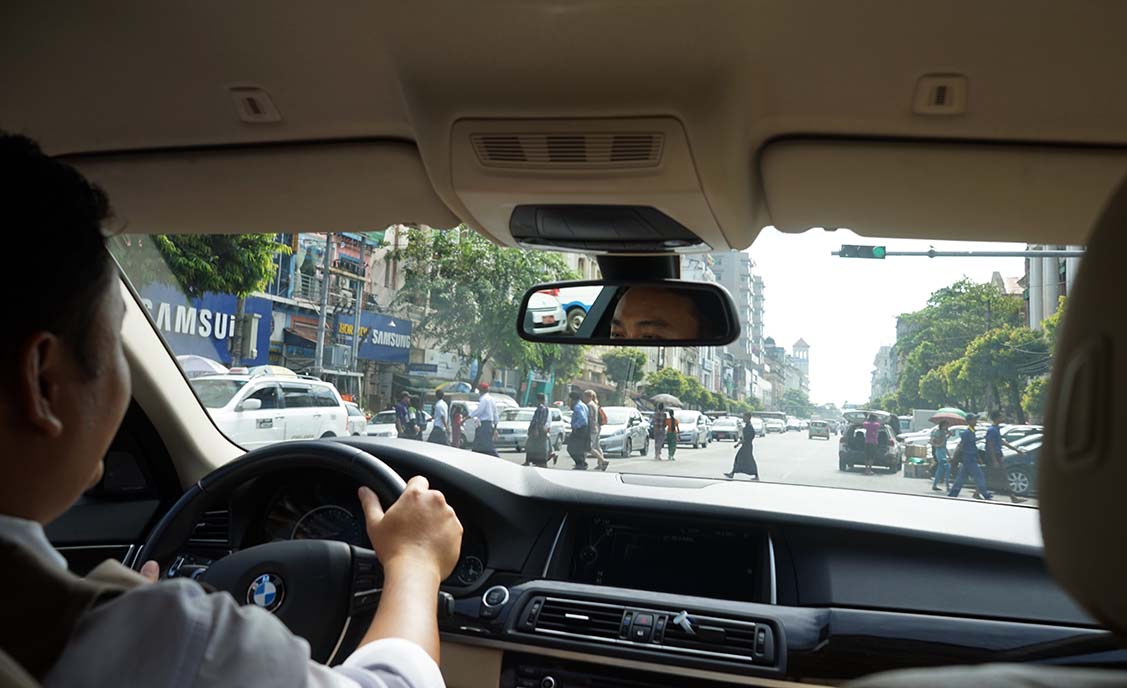
Props to our ParkRoyal hotel driver, for navigating these confusing and busy streets! Interestingly, motorcycles are banned in the city, so you won’t see street scenes similar to Vietnam. Still, people will cross the roads willy-nilly.

We saw children in school uniforms, and adults in matching longyi (the long Burmese tied skirts worn by men and women).

Our car passed by the Ganesh Hindu Temple. Buddhism is practised by about 88% of the population, but there are other religions here too.

As we drove through the narrow streets, our car windows were perfect for people-watching.

We noticed these covered drinking gourds, or pots of water that anyone can drink from.

Myanmar has a lot of investment from Korea and Japan, hence this street filled with technology stores. Smartphones are common here…
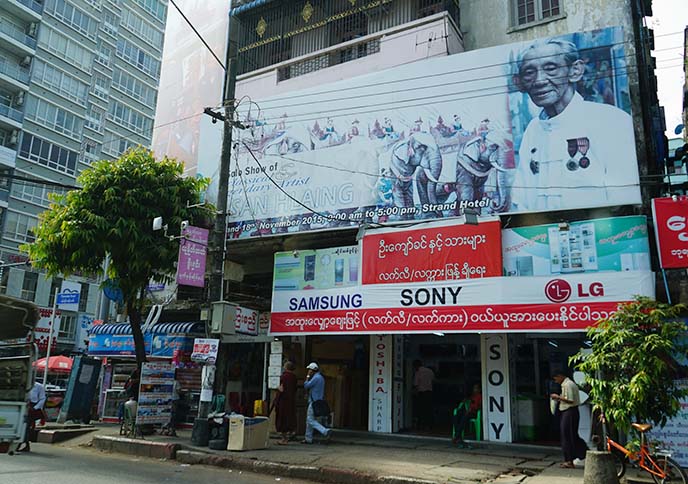
… as Samsung, Sony, LG and others have a large presence.

Modern and traditional are a true balance in Yangon. We’re very glad we came to Myanmar, and hope to see Bagan and more of the country next time.
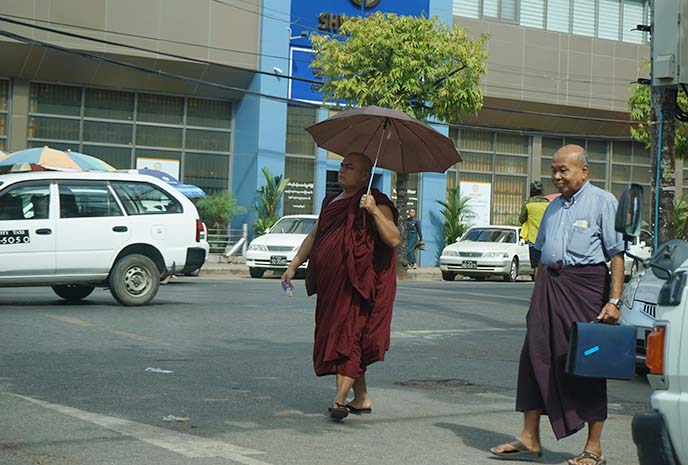
For more about Burmese Buddhism and monks, come see our story about the golden Shwedagon Pagoda.
Isn’t Myanmar a fascinating country? I’m glad to see the liberalisation of arts here, and look forward to these continued positive changes.
SHARE & COMMENT
Hipster Tallinn, Estonia! Contemporary art galleries, Telliskivi Creative City, Estonian design stores.

After the holidays and a much-needed catch up break, I’m thrilled to be on the road again!
I’m heading back to Europe this month, so I thought I’d do a final flash-back to my travels in Estonia.
Last summer, I explored the hipster side of Tallinn — art factories, local fashion and design collectives. (Remember when I visited the Estonian Depeche Mode bar?)

Next week, I’ll be back in the EU… this time, in the land of Miffy!
iAmsterdam is flying me to Amsterdam, where I’ll be covering the cool culture of the city. You may recall that I previously went to the Miffy / Nijntje museum in Utrecht, a kawaii dream come true. If you’re a fan of the Dutch bunny, check out these goodies below with a click:
I’m also heading to Athens, thanks to Marketing Greece! Get ready for the Acropolis, LGBT clubs and Greek island-hopping… Be sure to follow along on my Snapchat and Instagram (@lacarmina) for previews.
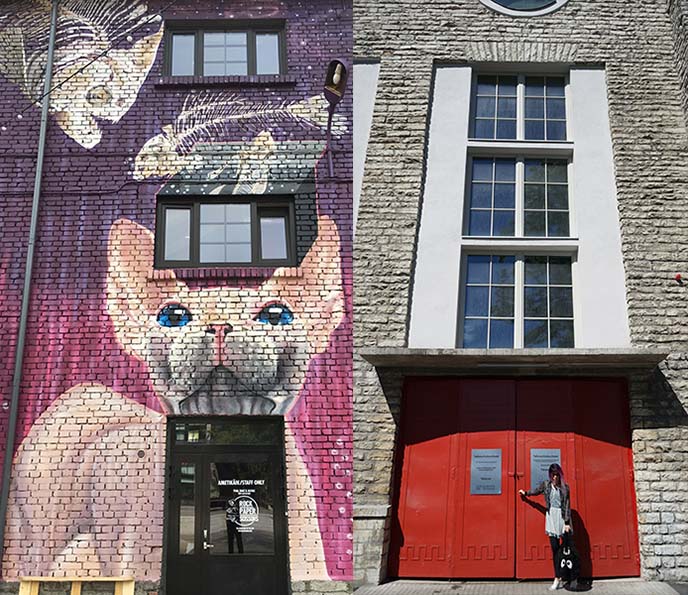
Now, let’s talk about Tallinn. As you can see from these photos alone, this is one hip city. My team and I encountered a burgeoning creative culture in Estonia, which is located south of Finland, north of Latvia, and west of Russia.

Estonia was a “Soviet socialist republic” from 1940-1991 (gaining independence when the USSR collapsed). This era resulted in some intriguing cyberpunk relics such as this apocalyptic steam plant, which has been converted into a creative art hub. (More about this later in the post).

If you’re interested in Tallinn’s art scene, you’ve got to visit Telliskivi Creative City. This abandoned factory area has been reclaimed as an urban space, and is now home to the biggest artistic hub in the country.
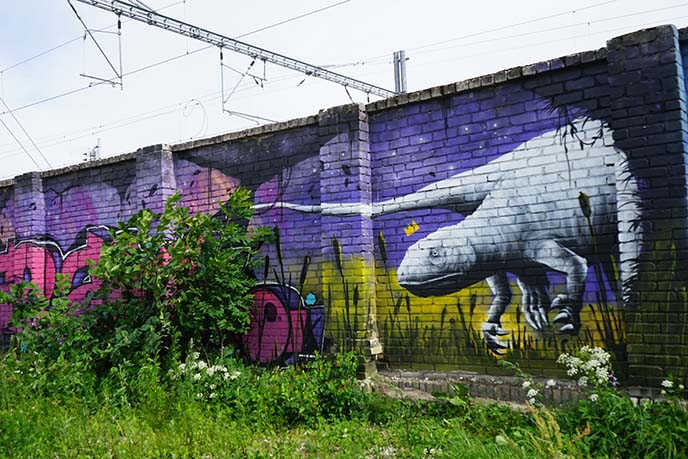
Telliskivi spans 25,000 square meters, and contains over 200 independent businesses and non-profits. The crumbling structures have been converted into an artistic, alternative, public space. For example, the run-down walls by the railroad tracks are now covered in colorful murals.
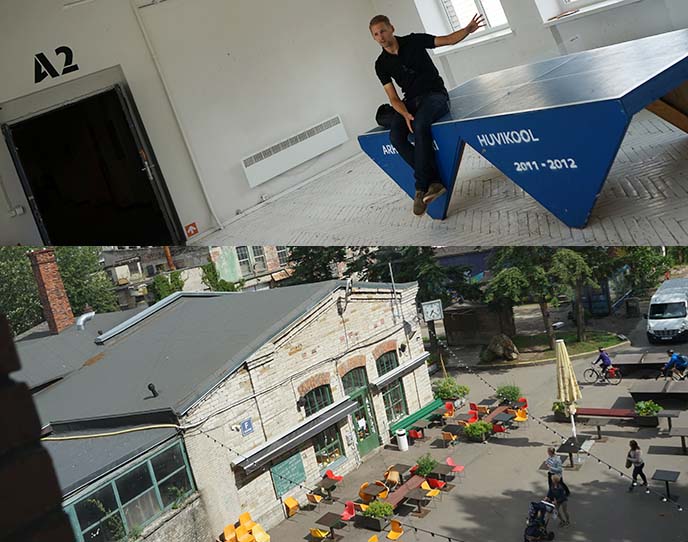
We met Jaanus Juss, the young founder and CEO of Telliskivi Loomelinnak. He talked about his vision of bringing together a wide variety of creatives, in an inspiring co-op space.

The “creative city” currently includes organic cafes, a printing shop, furniture makers, an antique book store, yoga studio, and childcare center. The residents also run regular dance evenings and flea markets.

The entire space is a canvas. As we walked around, we saw giant art installations and beautifully executed murals like the one above.

Telliskivi has revolving pop-up stores, which give local designers a chance to showcase their handmade arts, crafts and fashion.

Love these geometric concrete cacti planters.

In Telliskivi, the possibilities for artistic expression are endless. We passed by ateliers, workshops, a theater, galleries…

… and an architect’s studio (above). We also tasted the world’s best dark grain bread — no exaggeration — at Muhu Bakery (Muhu Pagarid). The brown rye loaves are baked fresh, with sunflower, hemp and flax seeds. Straight out of the oven, this hearty Estonian bread is a revelation!

Jaanus took us into one of the buildings that has yet to be restored. As we walked up the stairs, we glimpsed the scrawls of angels and demons.

We made it to the rooftop, where he pointed out the first graffiti in Estonia. (Street art was previously frowned upon in Tallinn.)

We had a brilliant view of the entire collective, including the bordering train tracks and Old Town.

Back on the ground, we took a peek inside a bike shop. The skull art caught my eye.
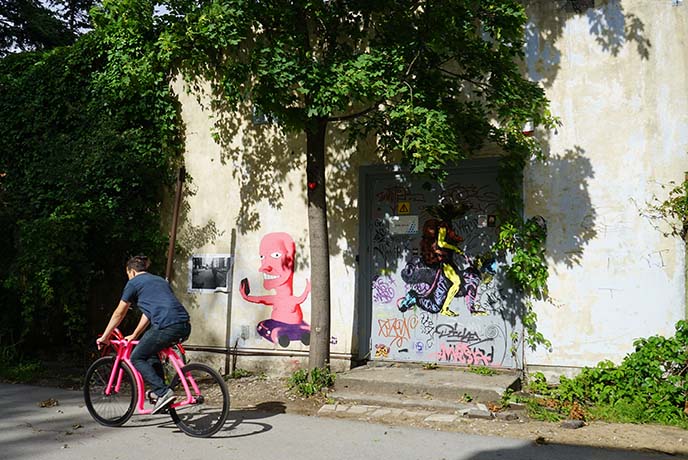
Telliskivi was established in 2009, but the Baltic Railway buildings date back to 1869. I’m eager to see how this vibrant, creative city will keep on evolving over time.

The Baltics (Lithuania, Latvia, Estonia) currently have a thriving artistic scene — perhaps because these countries are now free from the USSR, and spreading their wings creatively. Cities like Tallinn are liberal, yet have a low cost of living: the perfect breeding ground for young artists.
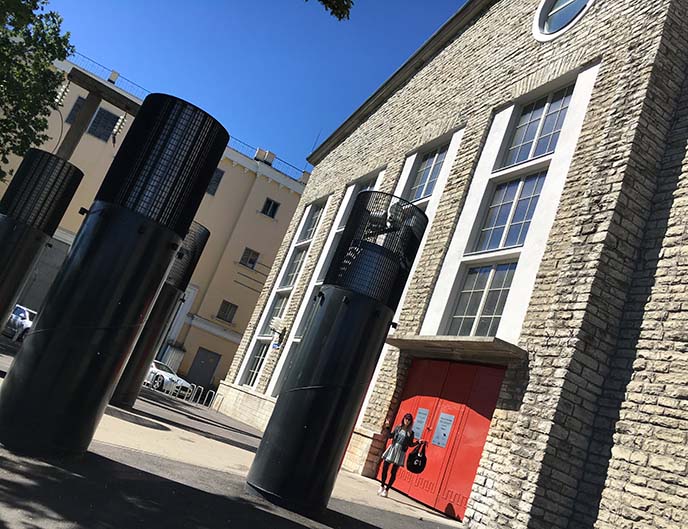
This is certainly the case at Tallinn Creative Hub, a center for cultural events in the heart of the city. Behind these big red doors, there are workshops, festivals, exhibits, seminars and other creative enterprises.

This building was once the Tallinn City Central Power Station, which operated between 1913 and 1979. The current incarnation preserves the boiler room, gas reservoir and brick chimney — giving the venue a Steampunk meets Gothic vibe.

In 1977, director Andrei Tarkovsky used the power plant as the set for his cult film, “Stalker.” My jaw dropped when I walked into “Cauldron Hall” — a high-ceilinged room that looks straight out of Mad Max or Blade Runner!

These precarious, rusted ladders and balconies look like a post-apocalyptic set. It can be rented out for events — I’d have an epic “end of the world” party here.

Tallinn Creative Hub’s cavernous spaces include a Maker Lab (workshop with various machines), recording studio, and food lab (for experimenting with recipes). There’s also a community garden and cafe, free for locals to enjoy.

Outside, I walked up the “stairway to nowhere” — Linnahall. It’s a large, grey, concrete staircase that doesn’t really lead to anything (how surreal and Soviet)! Linna Hall was a sports venue built for the 1980 Olympics, situated on the harbour, but it’s fallen into disuse today.

Back to Old Town, where we popped into the design store Tali. Everything here is made by local designers — jewelry, leather goods, clothing, and furniture.

I’m a fan of modern Estonian designs, which tend to have minimal, geometric forms (as characteristic of Northern Europe). The works are stylish, yet with a sense of humor.

The cute animal sleep masks and wooden bow ties were among my favorites, and are great souvenirs.
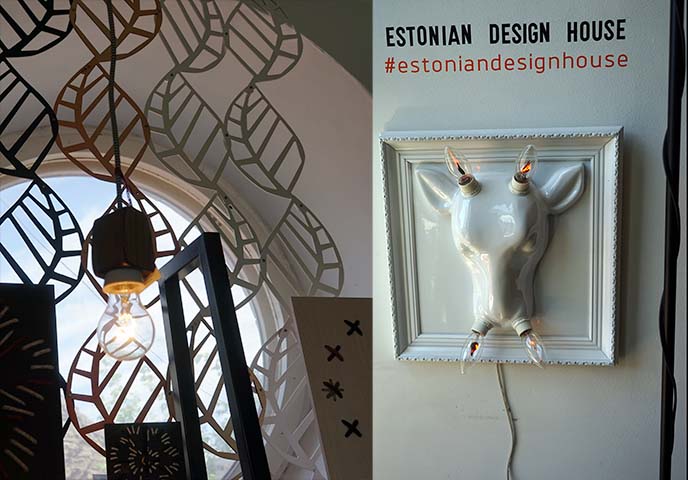
We also paid a visit to Estonian Design House, home to several studios and the headquarters of the Estonian Association of Designers.
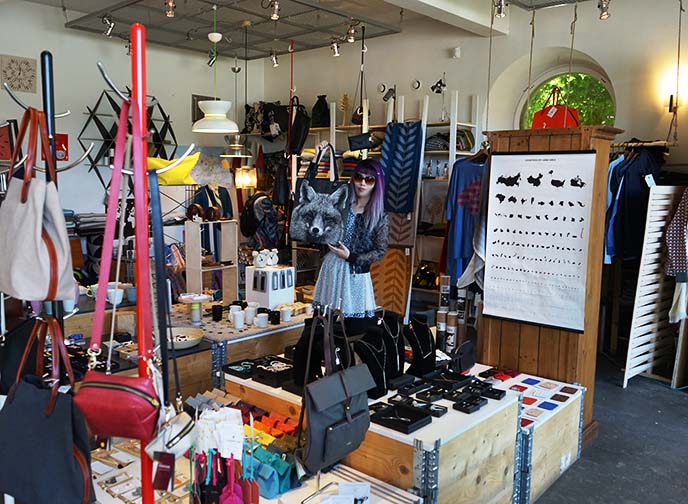
There’s an impressive selection of upcycled fashion, quirky lighting, hipster backpacks, sleek jewelry and posters.
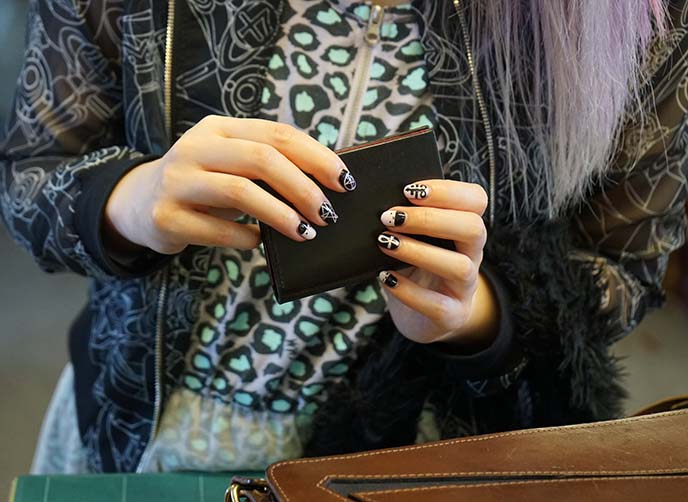
Upstairs, I got a tour of Stella Soomlais studio. She makes custom leather accessories for men and women, such as the sleek black wallet I’m holding.
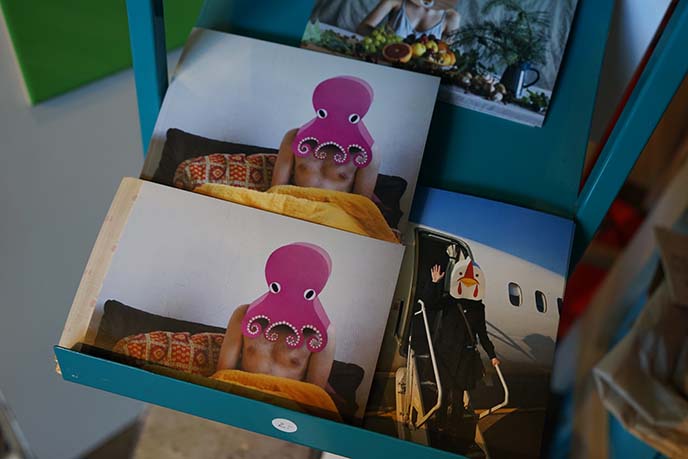
I love how Estonian art isn’t afraid to “keep it weird.” The octopus and rooster-headed photographs made me laugh.
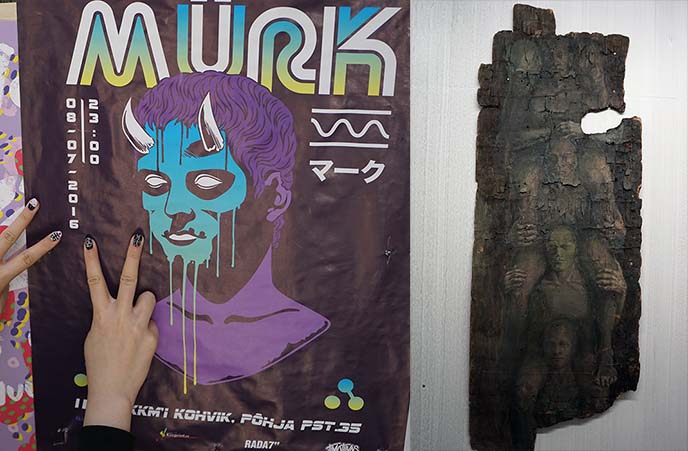
Last stop: the Contemporary Art Museum of Estonia (EKKM). This non-profit initiative has a DIY feeling, with a cafe in the entrance hall, and an adorable flower garden in the back.
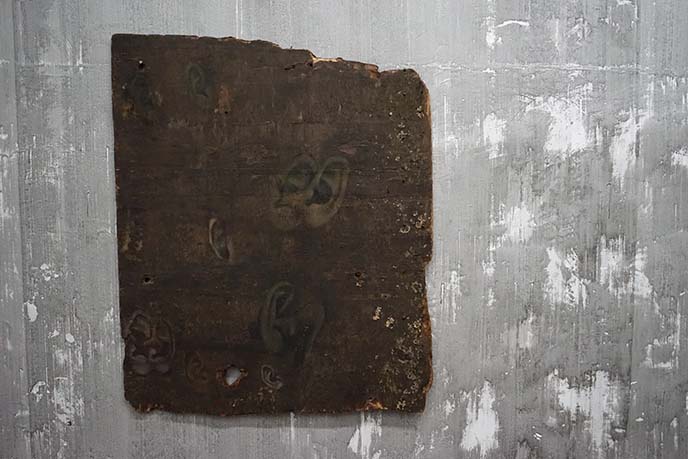
We saw the self-titled solo exhibition of Alice Kask, an Estonian painter. Her works use materials such as old wooden boards, which stand out against the stark, industrial walls.
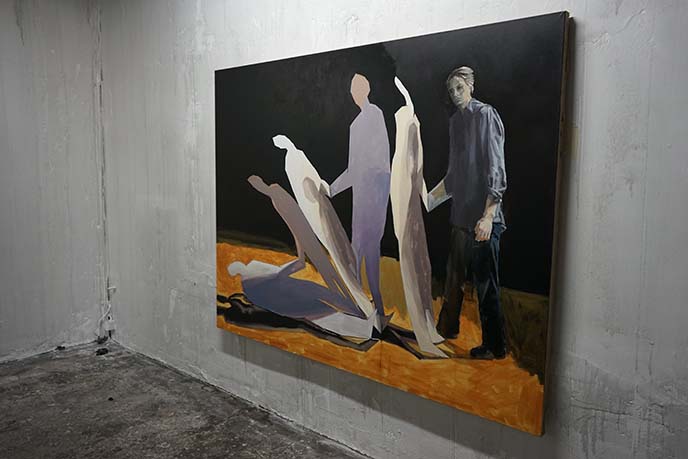
Alice Kask’s works have elements of surrealism, which I love. They touch upon themes such as the body, media images, and symbolism vs reality.

The Contemporary Art Museum of Tallinn brings in works both from Estonia and worldwide. Their rotating exhibitions always have a strong voice.
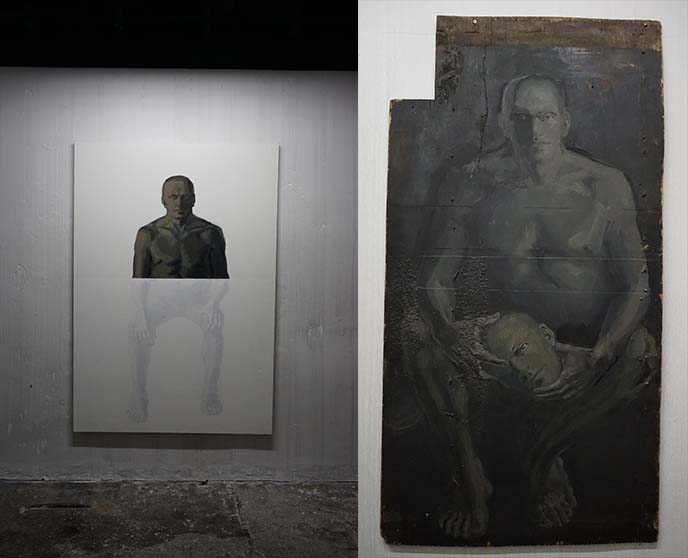
Her painting style is striking and a bit unnerving. Alice depicts human bodies with realistic strokes, but then gives them a bizarre twist and surrounds them in abstract space.
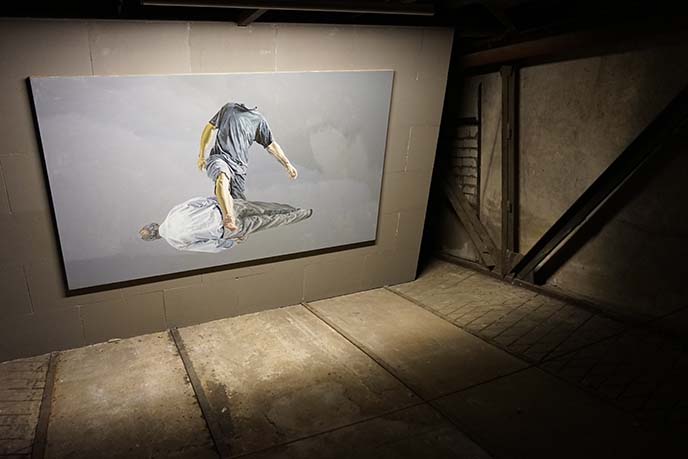
Isn’t the art scene in Estonia intriguing? Thanks to Visit Tallinn for inviting us, and showing us around.
(All photos by Borderless Media.)
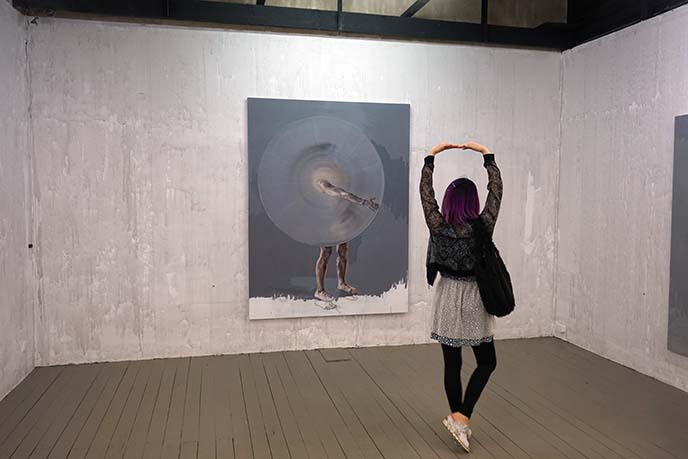
For more, check out my post about Estonian cuisine and the Depeche Mode bar here.
And now, I’m off to Europe again… dancing with joy. Can’t wait to share travel stories from Amsterdam and Athens with you soon!

 LA CARMINA
LA CARMINA






